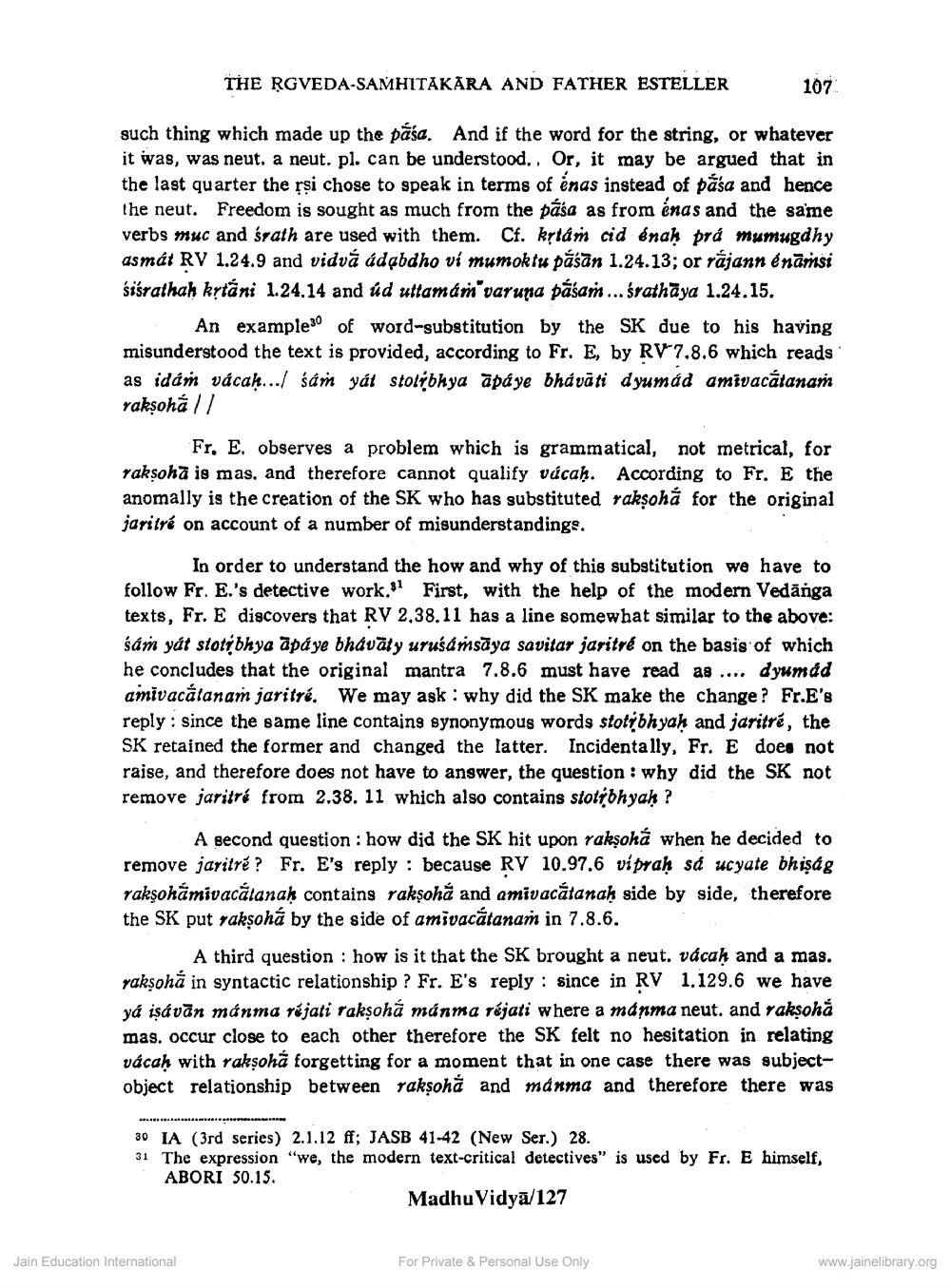________________
THE RGVEDA-SAMHITAKARA AND FATHER ESTELLER
107
such thing which made up the pása. And if the word for the string, or whatever it was, was neut. a neut. pl. can be understood., Or, it may be argued that in the last quarter the rşi chose to speak in terms of enas instead of pása and hence the neut. Freedom is sought as much from the pása as from énas and the same verbs muc and śrath are used with them. Cf. kytam cid enaḥ prá mumugdhy asmát RV 1.24.9 and vidvá ádabdho vi mumoktu pásan 1.24.13; or rájann énāmsi śiśrathah kytáni 1.24.14 and úd uttamám varuna pášam ... srathāya 1.24.15.
An example30 of word-substitution by the SK due to his having misunderstood the text is provided, according to Fr. E, by RV 7.8.6 which reads as idám vácah... śám yát stolíbhya āpáye bhávāti dyumád amivacátanam raksoha //
Fr, E. observes a problem which is grammatical, not metrical, for Taksoha is mas, and therefore cannot qualify vácah. According to Fr. E the anomally is the creation of the SK who has substituted raksoha for the original jaritré on account of a number of misunderstandinge.
In order to understand the how and why of this substitution we have to follow Fr. E.'s detective work. First, with the help of the modern Vedānga texts, Fr. E discovers that RV 2.38.11 has a line somewhat similar to the above: śán yát stotibhya apa ye bhavāty uruśámsāya savitar jaritré on the basis of which he concludes that the original mantra 7.8.6 must have read as .... dyumdd amivacátanam jaritré. We may ask : why did the SK make the change? Fr.E's reply: since the same line contains synonymous words stotybhyah and jaritré, the SK retained the former and changed the latter. Incidentally, Fr. E does not raise, and therefore does not have to answer, the question : why did the SK not remove jaritré from 2.38. 11 which also contains stolybhyah ?
A second question : how did the SK hit upon rakşohá when he decided to remove jaritré ? Fr. E's reply : because RV 10.97.6 vipraḥ så ucyate bhişág rakşohámivacátanak contains raksoha and amivacátanah side by side, therefore the SK put raksohá by the side of amivacátanaṁ in 7.8.6.
A third question : how is it that the SK brought a neut. vácah and a mas. yakşohả in syntactic relationship ? Fr. E's reply : since in RV 1.129.6 we have yá işávān mánma réjati rakṣohá mánma réjati where a manma neut. and raksoha mas. occur close to each other therefore the SK feit no hesitation in relating vácah with rakşohá forgetting for a moment that in one case there was subjectobject relationship between rakşoha and manma and therefore there was
30 IA (3rd series) 2.1.12 ff; JASB 41-42 (New Ser.) 28. 31 The expression "we, the modern text-critical detectives" is used by Fr. E himself, ABORI 50.15.
Madhu Vidyā/127
Jain Education International
For Private & Personal Use Only
www.jainelibrary.org




